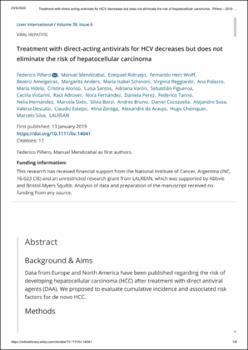| dc.description.abstract | Abstract
Background & Aims: Data from Europe and North America have been published re‐
garding the risk of developing hepatocellular carcinoma (HCC) after treatment with
direct antiviral agents (DAA). We proposed to evaluate cumulative incidence and as‐
sociated risk factors for de novo HCC.
Methods: This was a prospective multicentre cohort study from Latin America includ‐
ing 1400 F1‐F4‐treated patients with DAAs (F3‐F4 n = 1017). Cox proportional re‐
gression models (hazard ratios, HR and 95% CI) were used to evaluate independent
associated variables with HCC. Further adjustment with competing risk regression
and propensity score matching was carried out.
Results: During a median follow‐up of 16 months (IQR 8.9‐23.4 months) since DAAs ini‐
tiation, overall cumulative incidence of HCC was 0.02 (CI 0.01; 0.03) at 12 months and
0.04 (CI 0.03; 0.06) at 24 months. Cumulative incidence of HCC in cirrhotic patients
(n = 784) was 0.03 (CI 0.02‐0.05) at 12 months and 0.06 (CI 0.04‐0.08) at 24 months of
follow‐up. Failure to achieve SVR was independently associated with de novo HCC with
a HR of 4.9 (CI 1.44; 17.32), after adjusting for diabetes mellitus, previous interferon
non‐responder, Child‐Pugh and clinically significant portal hypertension. SVR presented
an overall relative risk reduction for de novo HCC of 73% (CI 15%‐91%), 17 patients
were needed to be treated to prevent one case of de novo HCC in this cohort.
Conclusions: Achieving SVR with DAA regimens was associated with a significant risk
reduction in HCC. However, this risk remained high in patients with advanced fibro‐
sis, thus demanding continuous surveillance strategies in this population. | en_US |


